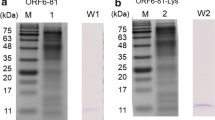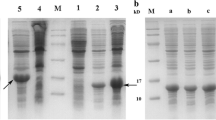Abstract
M13 is a filamentous Escherichia coli virus covered with five types of capsid proteins, in which pVIII with ~2700 copies was around the cylindered surface and pIII with five copies located at one end of the phage particle. The pIII-engineered M13 phages with enhanced binding specificity toward Fe were screened after five rounds of biopanning, and the one containing ATPTVAMSLSPL peptide at pIII-terminus was selected for mediated synthesis of zero valent (ZV) Fe nanoparticles (NPs) with the wild M13 as control. Under a reducing environment, uniformly dispersed ZVFeNPs with diameter of 5–10 nm were both synthesized and the morphologies after annealing were confirmed to be face-centered cubic type. The synthesized FeNPs mediated by the two phages showed no significant difference, revealing that the pVIII capsid did dominant contribution to metal binding in comparison with the pIII. A novel pVIII-engineered M13 containing AAEEEDPAK at terminus, named as 4ED-pVIII-M13, was constructed and it carried one more negatively charged residue than the wild one (AEGDDPAK). Metal adsorption quantification showed that the binding affinity of the 4ED-pVIII-M13 toward Ag and Ni ions improved to 62 and 18 % from original 21 and 6 %, respectively. The binding affinity toward Fe remained constant (~85 %). ZVFe–Ag bi-NPs were successfully synthesized through mediation of 4ED-pVIII-M13. Particularly, the Fe:Ag ratio in the bi-NPs was conveniently controlled through changing the molar concentration of FeCl2 and AgNO3 solution before reduction.









Similar content being viewed by others
References
Chang SJ, Inseong H, Taek DC (2013) Virus-tethered magnetic gold microspheres with biomimetic architectures for enhanced immunoassays. Adv Funct Mater 23:1484–1489
Dang X, Yi H, Ham MH, Qi J, Yun DS, Ladewski R, Strano MS, Hammond PT, Belcher AM (2011) Virus-templated self-assembled single-walled carbon nanotubes for highly efficient electron collection in photovoltaic devices. Nat Nanotechnol 6:377–384
Huang Y, Chiang CY, Lee SK, Gao Y, Hu EL, De YJ, Belcher AM (2005) Programmable assembly of nanoarchitectures using genetically engineered viruses. Nano Lett 5:1429–1434
Jabeen H, Chandra V, Jung S (2011) Enhanced Cr(VI) removal using iron nanoparticle decorated graphene. Nanolscale 3:3583–3585
Lee SW, Lee SK, Belcher AM (2003) Virus-based alignment of inorganic, organic, and biological nanosized materials. Adv Mater 15:689–692
Lee YJ, Yi H, Kim WJ, Kang K, Yun DS, Strano MS, Ceder G, Belcher AM (2009) Fabricating genetically engineered high-power lithium-ion batteries using multiple virus genes. Science 324:1051–1055
Lee Y, Kim Y, Yun J, Soo D (2012) Virus-templated Au and Au–Pt core–shell nanowires and their electrocatalytic activities for fuel cell applications. Energy Environ Sci 5:8328–8334
Li XQ, Elliott DW, Zhang WX (2006) Zero-valent iron nanoparticles for abatement of environmental pollutants: materials and engineering aspects. Criti Rev Solid State Mater Sci 31:111–122
Ling T, Yu H, Shen Z, Wang H, Zhu J (2008) Virus-mediated FCC iron nanoparticle induced synthesis of uranium dioxide nanocrystals. Nanotechnology 19:115608–115613
Ling T, Xie L, Zhu J, Yu HM, Ye HQ, Yu R, Cheng Z, Liu L, Yang GW (2009a) Icosahedral face-centered cubic Fe nanoparticles: facile synthesis and characterization with aberration-corrected TEM. Nano Lett 9:1572–1576
Ling T, Zhu J, Yu H, Xie L (2009b) Size effect on crystal morphology of faceted face-centered cubic Fe nanoparticles. J Phys Chem C 113:9450–9453
Mao CB, Solis DJ, Reiss BD, Kottmann ST, Sweeney RY, Hayhurst A, Georgiou G, Iverson B, Belcher AM (2004) Virus-based toolkit for the directed synthesis of magnetic and semiconducting nanowires. Science 303:213–217
Marchetti SG, Cagnoli MV, Alvarez AM, Bengoa JF, Gallegos NG, Yeramian AA, Mercader RC (2002) Iron uniform size nanoparticles dispersed on MCM-41 used as hydrocarbon synthesis catalyst. Hyper Interact 139:33–40
Martin JE, Herzing AA, Yan W, Li XQ, Koel BE, Kieley CJ, Zhang WX (2008) Determination of the oxide layer thickness in core-shell zerovalent iron nanoparticles. Langmuir 24:4329–4334
Merzlyak A, Lee SW (2006) Phage as templates for hybrid materials and mediators for nanomaterial synthesis. Curr Opin Chem Biol 10:246–252
Miura Y, Sasao Y, Kamihira M, Sakaki A, Iijima S, Kobayashi K (2004) Peptides binding to a Gb3 mimic selected from a phage library. Biochim Biophys Acta 1673:131–138
Moon CH, Zhang ML, Myung NV, Haberer ED (2014) Highly sensitive hydrogen sulfide (H2S) gas sensors from viral-templated nanocrystalline gold nanowires. Nanotechnol 25:135205–135213
Moyano DF, Rotello VM (2011) Nano meets biology: structure and function at the nanoparticle interface. Langmuir 27:10376–10385
Oh JW, Chung WJ, Heo K, Jin HE, Lee BY, Wang W, Meyer J, Kim C (2014) Biomimetic virus-based colourimetric sensors. Nat Commun 5:4043–4050
Patwardhan AV, Goud GN, Koepsel RR, Ataai MM (1997) Selection of optimum affinity tags from a phage-displayed peptide library application to immobilized copper(II) affinity chromatography. J Chromatogr A 787:91–100
Sambrook J, Russell DW (2001) Molecular cloning: a laboratory manual. Cold Spring Harbor Press, New York
Shih YH, Tai YT (2010) Reaction of decabrominated diphenyl ether by zerovalent iron nanoparticles. Chemosphere 78:1200–1206
Singh R, Singh A, Misra V, Singh RP (2011) Degradation of lindane contaminated soil using zero-valent iron nanoparticles. J Biomed Nanotechnol 7:177–178
Sun YP, Li XQ, Cao J, Zhang WX, Wan HP (2006) Characterization of zero-valent iron nanoparticles. Adv Colloid Interface Sci 120:47–56
Wang YA, Yu X, Overman S, Tsuboi M, Thomas GJ, Egelman EH (2006) The structure of a filamentous bacteriophage. J Mol Biol 361:209–215
Xu Z, Sun H, Gao F, Hou L, Li N (2012) Synthesis and magnetic property of T4 virus-supported gold-coated iron ternary nanocomposite. J Nanopart Res 14:1–12
Zhang S, Nakano K, Yu H, Shen Z (2014) Bio-nano complexes of ZVFeNPs/Fe-s-M13 and Cd (II)/Cd-s-M13 accelerate Cd (II) reduction by FeNPs through dual dispersing and separate deposition. Mater Res Express 1:015043
Zhu L, Zhang J, Guo Y (2014) Enhanced detection and desalting free protocol for phosphopeptides eluted from immobilized Fe(III) affinity chromatography in direct MALDI TOF analysis. J Proteom 96:360–365
Acknowledgments
This work was supported by the National Natural Science Foundation of P. R. China (No. 21176143), National Key Basic Research Project (973 Program; 2013CB733600), and the Project-sponsored by the Returned Overseas Chinese Scholars.
Author information
Authors and Affiliations
Corresponding author
Rights and permissions
About this article
Cite this article
Zhang, S., Nakano, K., Zhang, Sl. et al. Synthesis of dispersive iron or iron–silver nanoparticles on engineered capsid pVIII of M13 virus with electronegative terminal peptides. J Nanopart Res 17, 417 (2015). https://doi.org/10.1007/s11051-015-3221-0
Received:
Accepted:
Published:
DOI: https://doi.org/10.1007/s11051-015-3221-0




